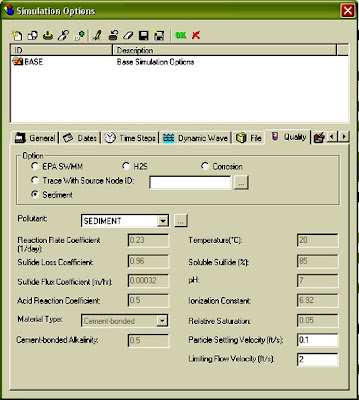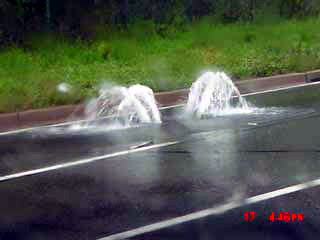Option "Define Supercritical Flow By" does inside the SWMM 5 engine. The options are called Slope, Froude and Bothin the GUI and in the engine of SWMM 5. A few other variable definitions you need to know to understand this explanation are: (1) Y1 for the upstream link depth, (2) Y2 for the downstream link depth, (3) Q for the flow in the link, (4)Qfull for the full Manning's equation flow or normal flow for the link based on the bed slope, (5) Froude1 and Froude2 for the Froude Number respectively of the upstream and downstream ends of the link, (6) n for Manning's roughness, (7) Yfull for the maximum depth of the link and (8) Qnormal for the Normal Flow equation flow based on the upstream area of the link (A1) and the upstream hydraulic radius (R1).
 In the SWMM 5 engine these options are used after the dynamic wave equation flow is estimated using the St. Venant equation. The option that you choose is only active for those links that have a flow greater than 0, links with negative flow use the dynamic wave equation flow exclusively. It the flow is positive and the link is an open channel and full then the minimum of the dynamic wave flow or Qfull is used as the new flow in the link. If the flow is positive and the depth at the upstream end of the link or Y1 is less than Yfull then the engine will compare Qnormal to Q using the routines in Check Normal Flow.
In the SWMM 5 engine these options are used after the dynamic wave equation flow is estimated using the St. Venant equation. The option that you choose is only active for those links that have a flow greater than 0, links with negative flow use the dynamic wave equation flow exclusively. It the flow is positive and the link is an open channel and full then the minimum of the dynamic wave flow or Qfull is used as the new flow in the link. If the flow is positive and the depth at the upstream end of the link or Y1 is less than Yfull then the engine will compare Qnormal to Q using the routines in Check Normal Flow.
If the link gets to the Check Normal Flow routines then it uses the following logic:

How does this work in the actual flow that SWMM 5 estimates for a link? Consider this example in which the link flow in blue is plotted with the Qnormal flow in red and the Q dynamic wave equation flow in purple:
Qnormal is

Qnormal is only calculated when the link is not full so in the plot a Qnormal of 0 means that the pipe was full. At other times the flow in the link was equal to Qnormal as the minimum of the dynamic equation flow or the Qnormal flow is used at each iteration in the solution process. The flow is normally bounded by the Qnormal flow in SWMM 5.0.013. Your choice of the options Slope, Froude andBoth really only impact the conditions under which this comparison is true. If you use Froude or Both then Supercritical flow at either end of the link will trigger this comparison will be the dynamic wave equation flow and the Froude number at each end of the link.
If the link gets to the Check Normal Flow routines then it uses the following logic:
- If the Slope or Both option is used or either the upstream node or the downstream node of the link is an outfall AND Y1 is less than Y2 then the minimum of Q from the dynamic wave equation or Q from the Normal Flow equation is used as the current iteration flow in link, or
- If the Froude or Both option AND either the upstream Froude Number or the downstream Froude number is greater than 1 then the minimum of Q from the dynamic wave equation or Q from the Normal Flow equation is used as the current iteration flow in link. This condition is never used if either of the connecting nodes of the link are outfalls.
How does this work in the actual flow that SWMM 5 estimates for a link? Consider this example in which the link flow in blue is plotted with the Qnormal flow in red and the Q dynamic wave equation flow in purple:
Qnormal is
Qnormal is only calculated when the link is not full so in the plot a Qnormal of 0 means that the pipe was full. At other times the flow in the link was equal to Qnormal as the minimum of the dynamic equation flow or the Qnormal flow is used at each iteration in the solution process. The flow is normally bounded by the Qnormal flow in SWMM 5.0.013. Your choice of the options Slope, Froude andBoth really only impact the conditions under which this comparison is true. If you use Froude or Both then Supercritical flow at either end of the link will trigger this comparison will be the dynamic wave equation flow and the Froude number at each end of the link.
















